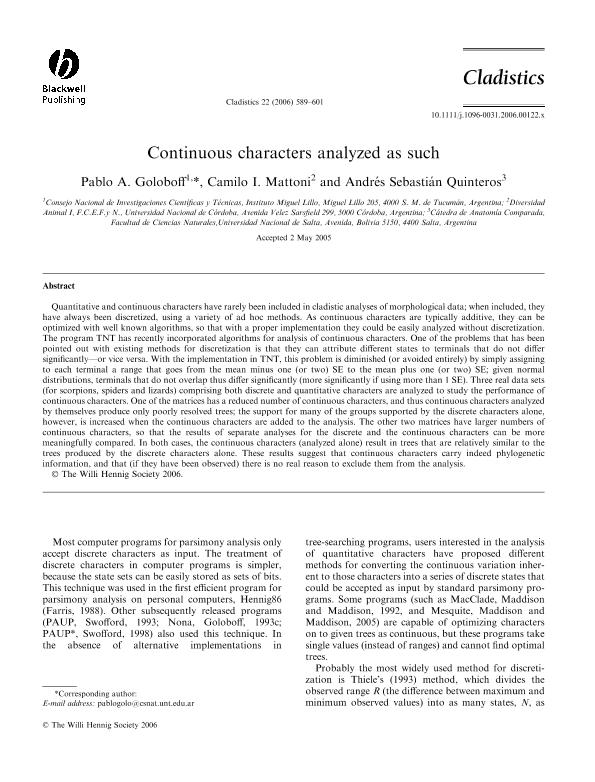Artículo
Continuous characters analyzed as such
Fecha de publicación:
12/2006
Editorial:
Wiley Blackwell Publishing, Inc
Revista:
Cladistics
ISSN:
0748-3007
Idioma:
Inglés
Tipo de recurso:
Artículo publicado
Clasificación temática:
Resumen
Quantitative and continuous characters have rarely been included in cladistic analyses of morphological data; when included, they have always been discretized, using a variety of ad hoc methods. As continuous characters are typically additive, they can be optimized with well known algorithms, so that with a proper implementation they could be easily analyzed without discretization. The program TNT has recently incorporated algorithms for analysis of continuous characters. One of the problems that has been pointed out with existing methods for discretization is that they can attribute different states to terminals that do not differ significantly—or vice versa. With the implementation in TNT, this problem is diminished (or avoided entirely) by simply assigning to each terminal a range that goes from the mean minus one (or two) SE to the mean plus one (or two) SE; given normal distributions, terminals that do not overlap thus differ significantly (more significantly if using more than 1 SE). Three real data sets (for scorpions, spiders and lizards) comprising both discrete and quantitative characters are analyzed to study the performance of continuous characters. One of the matrices has a reduced number of continuous characters, and thus continuous characters analyzed by themselves produce only poorly resolved trees; the support for many of the groups supported by the discrete characters alone, however, is increased when the continuous characters are added to the analysis. The other two matrices have larger numbers of continuous characters, so that the results of separate analyses for the discrete and the continuous characters can be more meaningfully compared. In both cases, the continuous characters (analyzed alone) result in trees that are relatively similar to the trees produced by the discrete characters alone. These results suggest that continuous characters carry indeed phylogenetic information, and that (if they have been observed) there is no real reason to exclude them from the analysis.
Palabras clave:
Phylogeny
,
Continuous Character
Archivos asociados
Licencia
Identificadores
Colecciones
Articulos(CCT - NOA SUR)
Articulos de CTRO.CIENTIFICO TECNOL.CONICET - NOA SUR
Articulos de CTRO.CIENTIFICO TECNOL.CONICET - NOA SUR
Articulos(CCT - SALTA-JUJUY)
Articulos de CTRO.CIENTIFICO TECNOL.CONICET - SALTA-JUJUY
Articulos de CTRO.CIENTIFICO TECNOL.CONICET - SALTA-JUJUY
Citación
Goloboff, Pablo Augusto; Mattoni, Camilo Ivan; Quinteros, Andres Sebastian; Continuous characters analyzed as such; Wiley Blackwell Publishing, Inc; Cladistics; 22; 6; 12-2006; 589-601
Compartir
Altmétricas




